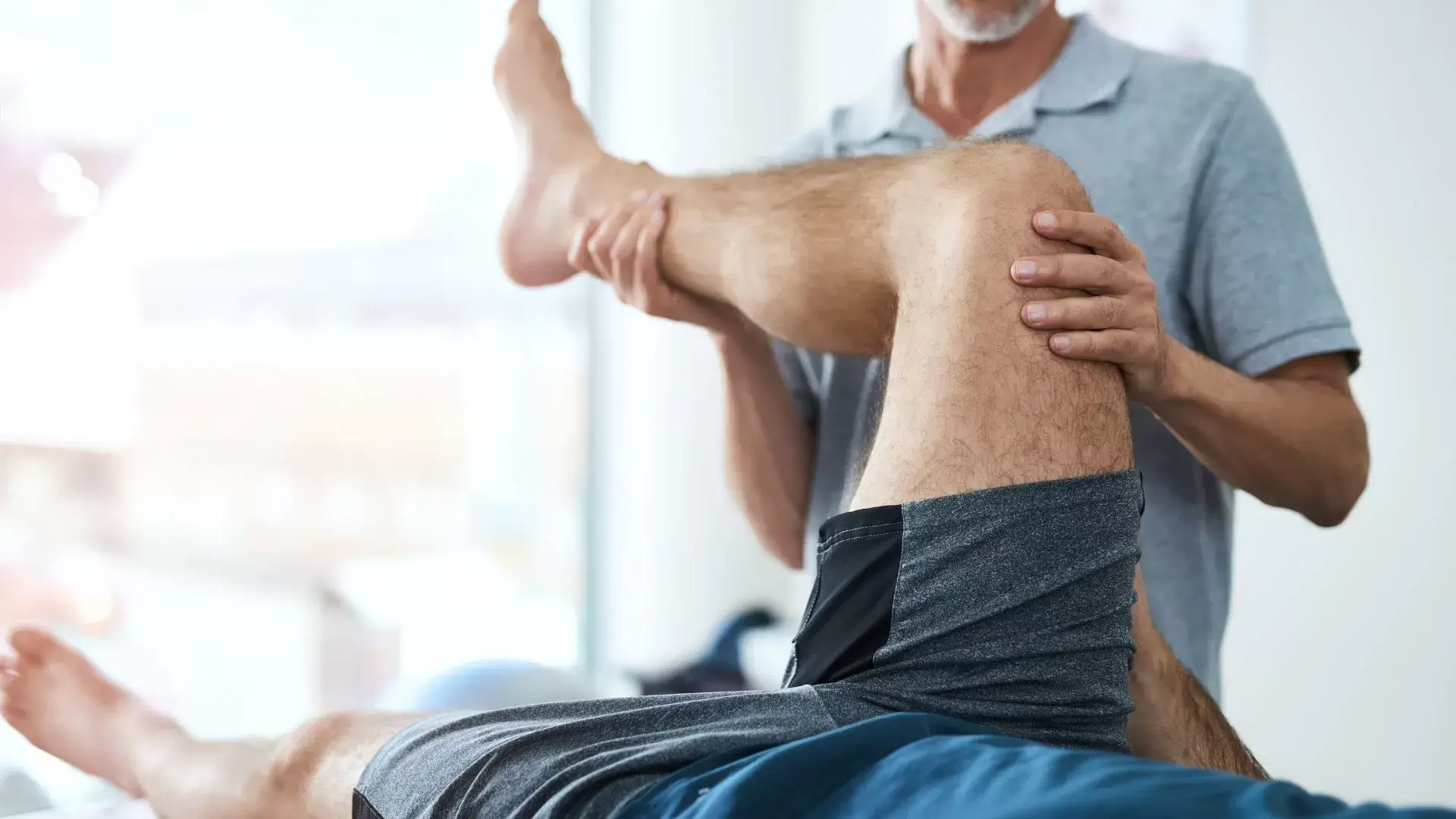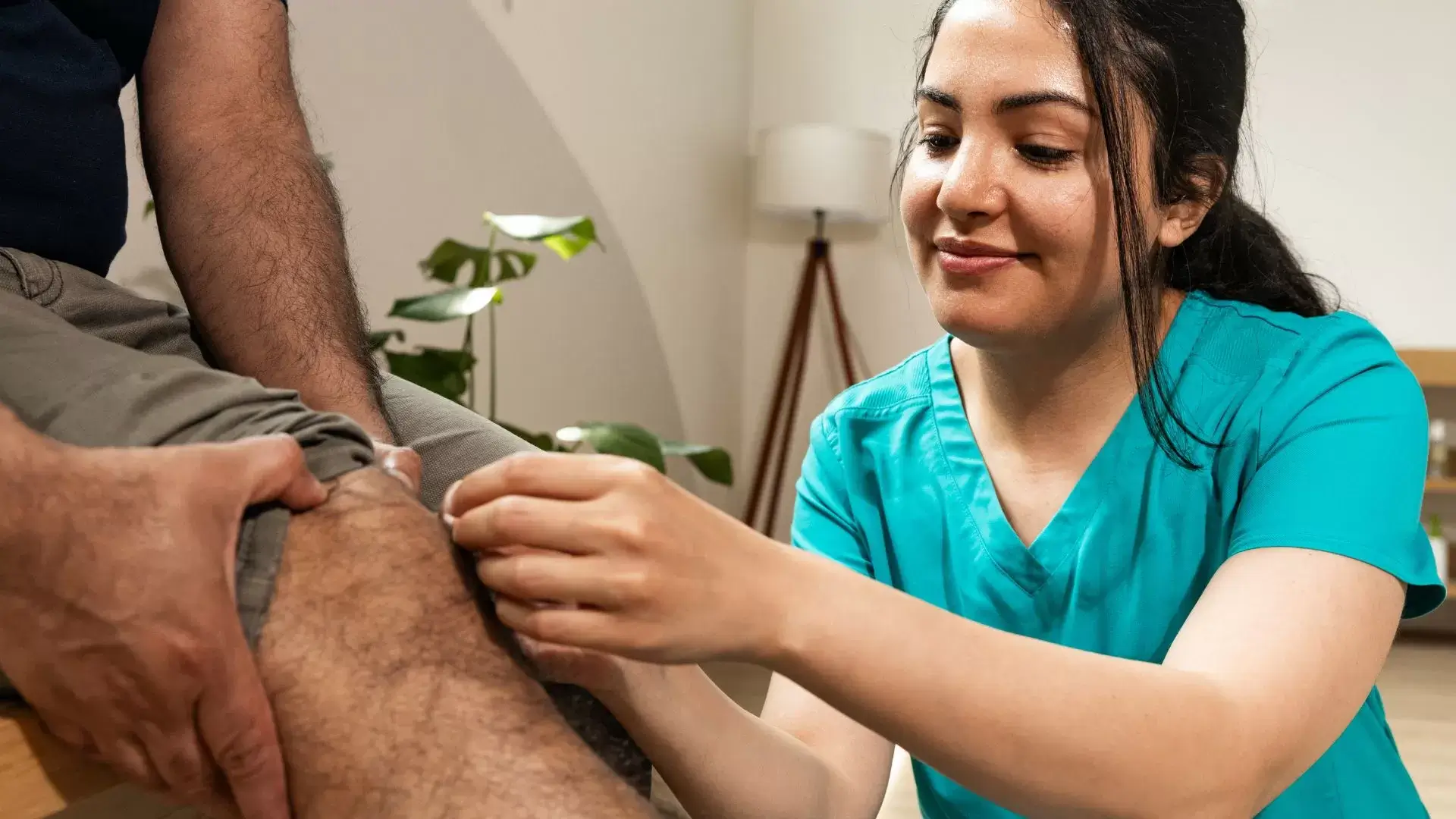We recognize how essential effective physiotherapy is for recovering from strains and sprains, and in Mississauga, we offer specialized Physiotherapy for Strains and Sprains with personalized care tailored to each individual’s needs. Our approach includes the RICE method for initial recovery, followed by targeted exercises that enhance strength, flexibility, and overall function. We focus on restoring stability and mobility while providing education on injury prevention. Our experienced physiotherapists in Mississauga assess your condition thoroughly to create a detailed rehabilitation plan. By prioritizing your health, we guarantee a smooth path to recovery. Explore with us how we can support your journey to wellness further.

At Mississauga Physio Chiro Clinic, we specialize in providing extensive physiotherapy and chiropractic services tailored to address strains and sprains effectively. We recognize that soft tissue injuries can greatly impact your daily life and athletic performance, which is why our dedicated team is here to assist you with thorough injury management strategies.
Our approach includes thorough strain diagnosis to identify the root cause of your discomfort. We develop personalized rehabilitation for sprains that incorporates essential first aid for sprains, ensuring you receive ideal care from the outset. Our skilled therapists guide you through targeted mobility exercises designed to restore function and flexibility, promoting a swift recovery.
Additionally, we emphasize the importance of strengthening for sprains, helping you build resilience against future injuries. For athletes, we offer specialized programs that integrate athletic training with our physiotherapy and chiropractic services, ensuring you’re not only recovering but also enhancing your performance.
Together, we’ll work towards your goals, providing ongoing support and tailored strategies to help you regain your strength and mobility. Your recovery journey is our priority, and we’re committed to guiding you every step of the way.
Understanding the nuances of strains and sprains is essential for effective recovery and prevention, as these common injuries can greatly affect both daily activities and athletic performance. Strains often involve the stretching or tearing of muscles or tendons, leading to muscle strain, joint pain, and inflammation. On the other hand, sprains affect ligaments, which connect bones at joints. A ligament sprain can result in swelling and significant discomfort.
Both injuries can cause soft tissue damage, impacting mobility and function. Tendon strain, a specific type of muscle strain, can also lead to chronic pain if not managed properly. The symptoms of these injuries can overlap, but recognizing the differences helps us tailor our approach to treatment.
In our quest for injury prevention, we should focus on proper warm-ups, strength training, and flexibility exercises. It’s vital to listen to our bodies, as early intervention can make a difference between a minor issue and a severe injury. By understanding the mechanisms behind strains and sprains, we empower ourselves to make informed decisions about our health and recovery strategies. Let’s work together to stay active and resilient.
What factors contribute to the occurrence of strains and sprains, and how can we mitigate their risk in our daily activities and sports? We often encounter various situations that can lead to injuries, whether it’s an ankle sprain during a game or a wrist sprain while lifting heavy objects. Acute sprains, like knee sprains, typically arise from sudden movements or falls, while chronic strains often develop from repetitive motions or overuse injuries.
Joint instability plays a significant role in these injuries, as weakened ligaments can easily suffer from ligament injury or tendon injury. Additionally, inadequate warm-up or stretching before physical activity increases the likelihood of sustaining sports injuries. We can reduce these risks by incorporating proper training techniques, maintaining strength and flexibility, and being mindful of our body mechanics during daily tasks.
Recognizing the symptoms of strains and sprains is essential for effective treatment and recovery, especially since these injuries can occur suddenly during sports or daily activities. We need to be aware of the common indicators so we can seek appropriate care. Strain symptoms often include pain, swelling, and limited mobility, whether it’s a back strain, shoulder strain, hamstring strain, or quadriceps strain.
In the case of a muscle tear, we may experience sharp pain and immediate weakness in the affected area. On the other hand, sprain symptoms typically involve a ligament tear, characterized by swelling, bruising, and instability in the joint. If we notice tenderness and difficulty bearing weight, it’s vital to assess the severity of the injury.
Additionally, tendon tears can lead to persistent pain and reduced function. Understanding these signs can guide us in monitoring our condition and determining when to pursue soft tissue rehabilitation. By recognizing the symptoms early, we can initiate appropriate interventions, allowing for a smoother recovery process and a return to our activities.

Diagnosing strains and sprains typically involves a thorough evaluation of our medical history, physical examination, and sometimes imaging tests to determine the extent of the injury. During our consultation, we’ll discuss any specific incidents that led to the injury, like a groin strain or a calf strain, and we’ll evaluate symptoms such as bruising and tenderness.
Our physical examination will focus on the affected area, checking for swelling and evaluating the range of motion. If we suspect a more complex injury, like a rotator cuff strain or a severe sprain, imaging tests such as X-rays or MRIs may be recommended to rule out fractures or more serious damage.
For less severe injuries, like a thumb sprain or a finger sprain, we can often diagnose based on our findings during the physical examination. A sprain diagnosis will guide us in developing an appropriate treatment plan. Understanding the nature of our injury is essential as it helps us determine the best physical therapy for strains. By accurately diagnosing our condition, we can effectively address our recovery needs and set realistic expectations for healing.
Utilizing targeted physiotherapy techniques can considerably enhance our recovery from muscle strains and help restore function more effectively. For instance, when we experience a neck strain or a hand sprain, it’s essential to assess the severity of the injury. Conditions like a mild sprain may require different interventions compared to a grade 1 sprain or more severe grade 2 and grade 3 sprains.
One of the foundational approaches we employ is the RICE method—rest, ice, compression, and elevation. This method helps reduce inflammation and supports initial healing. Following this, we focus on strain treatment that promotes muscle recovery and soft tissue repair through tailored exercises and modalities.
Our physiotherapy sessions are designed to improve flexibility, strength, and overall function. We utilize techniques like manual therapy and therapeutic exercises to specifically target the injured area, whether it’s a mild sprain or a more complex muscle strain. By committing to a structured rehabilitation plan, we can navigate the recovery process together, ensuring that we return to our daily activities stronger and more resilient.
Addressing ligament sprains effectively requires a thorough physiotherapy approach that focuses on restoring stability and function while minimizing pain and inflammation. We recognize that ligament healing can be a complex process, and our role is to guide you through it with tailored treatment plans.
Initially, we emphasize rest for strains to prevent further injury, combined with ice for sprains to reduce swelling and discomfort. Compression for injuries is also essential, as it helps manage swelling and supports the injured area. As we progress, we’ll introduce sprain exercises aimed at regaining strength and flexibility. These exercises are designed to gently challenge the ligament while promoting healing.
Additionally, we may incorporate bracing for sprains to provide extra support during recovery. Kinesiology taping can also be beneficial, as it helps stabilize the joint without restricting movement. Throughout the rehabilitation process, we’ll focus on elevation for swelling to enhance recovery. By following this extensive physiotherapy approach, we aim to facilitate a safe return to your daily activities and sports, ensuring you regain your strength and confidence.
While we’ve explored effective physiotherapy approaches for ligament sprains, it’s important to understand the distinctions between acute and chronic strains and sprains, as these classifications greatly influence treatment and recovery strategies. Acute strains and sprains typically arise suddenly, often due to a specific incident, like a fall or a work-related injury. In these cases, our focus is on acute strain care, which includes rest, ice, compression, and elevation. This approach helps manage swelling and pain, enabling us to restore a full range of motion through targeted stretching for strains.
On the other hand, chronic strains and sprains develop gradually, often due to repetitive strain injuries or prolonged stress on tendons. These conditions may require a more thorough physiotherapy strategy, emphasizing tendon recovery and orthopedic care. We’ll work on strengthening exercises and tailored rehabilitation programs to address the limited range of motion and improve overall function.
Understanding these differences guarantees that we provide the most efficient treatment for each individual’s needs in Mississauga, guiding them through both acute strain care and chronic sprain recovery for ideal outcomes.

Advanced physiotherapy techniques play an essential role in enhancing recovery from strains and sprains, helping patients regain strength and mobility more effectively. By employing modalities such as ultrasound therapy, electrical stimulation, and manual therapy, we can promote healing and reduce pain, allowing our patients to return to their daily activities sooner.
At our clinic located at 1834 Lakeshore Rd W unit 6C, Mississauga, ON L5J 1J7, we utilize these advanced techniques tailored to individual needs. Each patient’s recovery plan is designed after a thorough assessment, ensuring we address specific injuries effectively. Techniques like kinesiology taping can also support injured areas, providing stabilization without restricting movement.
Moreover, we emphasize the importance of education in our approach. By teaching patients about their conditions and the recovery process, we empower them to take an active role in their rehabilitation. As we work together, we can track progress and make necessary adjustments to treatment plans.
If you’re dealing with a strain or sprain and want to explore advanced physiotherapy techniques, don’t hesitate to contact us. We’re here to support your journey to recovery.
Incorporating strengthening and stretching exercises into our rehabilitation program can greatly enhance recovery from strains and sprains. These exercises play an essential role in restoring function, improving flexibility, and building muscle strength around the injured area. By focusing on these aspects, we can help guarantee a smoother and more effective recovery process.
Strengthening exercises are fundamental for rebuilding muscle support and stability. We can start with low-resistance movements, gradually increasing intensity as our strength improves. This progressive approach not only aids in recovery but also helps prevent future injuries.
On the other hand, stretching exercises are important for maintaining and improving flexibility. Tight muscles can hinder our recovery, so incorporating gentle stretches can alleviate tension and promote blood circulation. It’s important to listen to our bodies and avoid pushing through pain, as this could lead to further injury.
As we integrate these exercises into our routine, it’s beneficial to work with a physiotherapist who can tailor a program specific to our needs. This personalized approach guarantees that we’re performing exercises correctly and safely, maximizing our recovery and overall well-being.
Effectively managing severe cases of strains and sprains requires a thorough approach that prioritizes immediate care, proper assessment, and a structured rehabilitation plan. When we’re faced with a severe injury, our first step is to apply the R.I.C.E. method: Rest, Ice, Compression, and Elevation. This initial care helps reduce inflammation and pain, setting the stage for recovery.
Once the immediate symptoms are under control, we must conduct a detailed assessment. This helps us understand the extent of the injury and tailor our treatment accordingly. We may utilize imaging techniques, like X-rays or MRIs, to confirm the diagnosis and rule out any fractures.
Following assessment, we can develop a structured rehabilitation plan. This plan will vary based on the individual and the severity of the injury but typically includes a combination of physiotherapy exercises, manual therapy, and modalities like ultrasound or electrical stimulation. Our goal is to restore function, strength, and flexibility while minimizing the risk of re-injury.
Addressing sports-related strains and sprains through targeted therapy is essential for athletes seeking to regain their strength and mobility. We recognize that each injury is unique, requiring a personalized approach to treatment. Our focus is on restoring function while minimizing the risk of re-injury.
In the initial phase of therapy, we typically employ methods such as ice application, compression, and elevation to manage swelling and pain. Once the acute symptoms subside, we introduce gentle range-of-motion exercises to promote healing. Strengthening exercises are integrated gradually, allowing us to rebuild muscle support around the injured area.
Education plays a crucial role in our therapy sessions. We guide athletes on proper techniques and body mechanics to prevent future injuries. Additionally, we emphasize the importance of a well-rounded conditioning program that includes flexibility, strength, and aerobic training.
Throughout the rehabilitation process, we provide continuous support and encouragement. Our goal is to empower athletes to return to their sport with confidence. By addressing sports-related strains and sprains effectively, we not only enhance recovery but also contribute to long-term athletic performance and well-being.
When we treat work-related and repetitive strain injuries, our goal is to alleviate pain and restore functionality through tailored physiotherapy interventions. These injuries often stem from prolonged postures, repetitive motions, or excessive loads, and they can considerably impact our daily lives and work performance.
During our initial assessments, we carefully evaluate each patient’s specific condition, identifying the root causes of their injuries. This allows us to design a personalized treatment plan that may include manual therapy, exercise prescriptions, and ergonomic advice. By incorporating these elements, we aim to reduce inflammation, improve strength, and enhance flexibility in the affected areas.
Education plays a vital role in our approach. We empower our patients by teaching them about proper body mechanics and techniques to prevent further injury. Throughout the rehabilitation process, we maintain open communication, ensuring our patients feel supported and informed. We also monitor progress regularly, adjusting treatment strategies as needed to optimize recovery.
Ultimately, our commitment is to help individuals regain their function and return to their daily activities pain-free. Together, we can work towards achieving a healthier, more sustainable lifestyle, free from the limitations imposed by work-related injuries.
Preventing strains and sprains is vital for maintaining overall health and functionality, and physiotherapy offers valuable strategies to help us achieve this goal. One of the key components we can focus on is strengthening the muscles surrounding vulnerable joints. By targeting specific muscle groups through tailored exercises, we can enhance stability and reduce the risk of injury.
Additionally, improving our flexibility through physiotherapy is essential. Stretching routines can help increase our range of motion, making it less likely for us to experience strains during physical activities. We should also pay attention to our posture and body mechanics. A physiotherapist can provide us with guidance on proper techniques for lifting, bending, and performing daily tasks to minimize undue stress on our bodies.
Furthermore, we can benefit from personalized warm-up and cool-down routines before and after engaging in sports or exercise. These practices prepare our muscles and joints for activity and aid in recovery, ultimately keeping us injury-free. By actively participating in these preventative strategies, we can guarantee a healthier, more active lifestyle while considerably reducing the likelihood of strains and sprains.
While we focus on injury prevention, it’s equally important to understand how to support long-term recovery and rehabilitation for strains and sprains to secure ideal healing and functional restoration. Effective rehabilitation begins with a thorough assessment of the injury, allowing us to tailor a program that meets each individual’s needs.
We should prioritize a combination of rest, ice, compression, and elevation (RICE) initially to manage inflammation. As we progress, we can incorporate gentle range-of-motion exercises to restore flexibility and prevent stiffness. Strengthening exercises will follow, addressing any muscle imbalances that may have contributed to the injury.
Education plays a vital role in our recovery journey. We must be aware of our body’s signals, recognizing when to push forward and when to ease off. Incorporating functional movements and sport-specific drills helps us regain confidence and prepares us for a safe return to our regular activities.
Throughout this process, maintaining open communication with our healthcare providers guarantees we’re on track. By committing to a structured rehabilitation program, we can fully support our recovery and minimize the risk of future injuries, paving the way for long-term health and strength.
Seeking expert physiotherapy for strains and sprains in Mississauga can greatly enhance our recovery journey and guarantee we regain peak function. When we reach out to trained professionals, we benefit from personalized assessments that identify the specific needs of our injuries. This tailored approach guarantees that our treatment plans are effective and focused on our unique circumstances.
The physiotherapists in Mississauga are equipped with the latest techniques and technologies, enabling them to provide us with evidence-based care. They’ll guide us through targeted exercises that promote healing and strengthen the affected areas, preventing future injuries. Additionally, they’ll educate us about proper body mechanics and injury prevention strategies, assuring we’re well-informed as we move forward.
It’s essential to recognize that recovery doesn’t happen overnight. By committing to a structured physiotherapy program, we can expect gradual, consistent improvement in our mobility and strength. This collaborative process fosters trust and empowers us to take an active role in our recovery.
Let’s not hesitate to reach out for expert physiotherapy. Taking this step is vital in our journey towards ideal health and wellness, allowing us to return to our daily activities with confidence.
Mississauga, a vibrant city in Ontario, offers a rich blend of cultural diversity and community spirit that enhances the quality of life for its residents. As we explore this dynamic city, it’s clear that Mississauga isn’t just a place to live; it’s a thriving hub of opportunity and connection. With a population that reflects various ethnic backgrounds, we find an array of cultural festivals, restaurants, and community events that foster inclusivity.
Moreover, Mississauga is home to several parks and recreational facilities, promoting an active lifestyle for everyone. The city’s commitment to health and wellness is evident in its numerous sports programs and fitness initiatives, which resonate with our community values.
Transportation is also a strong point, with well-connected public transit options and easy access to major highways, making it convenient for residents and visitors alike.
As we focus on our health, particularly in the context of physiotherapy for strains and sprains, the supportive environment of Mississauga plays a crucial role. Here, we can easily access the care we need to recover and thrive, ensuring that our community remains healthy and engaged.

When it comes to physiotherapy treatment for strains and sprains, we typically see a duration ranging from a few weeks to several months. Generally, the number of sessions depends on the severity of the injury and our individual healing processes. We’ll often attend sessions 1-3 times per week, allowing our bodies adequate time to recover while receiving the necessary support. It’s crucial to stay consistent for ideal results and to speed up our recovery.
When it comes to insurance coverage for physiotherapy sessions, we’ve found that it often depends on our specific policy. Most plans do cover physiotherapy, but the extent of coverage can vary. It’s crucial for us to review our insurance details and confirm with our provider. If we have questions, reaching out to our insurance company can help clarify what’s included and guarantee we’re making the most of our benefits for treatment.
Yes, we can often continue exercising while undergoing physiotherapy, but it’s essential to consult our physiotherapist first. They’ll assess our injury and recommend appropriate exercises that won’t hinder our recovery. Staying active can help maintain our strength and mobility, but we must listen to our bodies and avoid any movements that cause pain. With the right guidance, we can safely incorporate exercise into our rehabilitation plan.
When attending our physiotherapy appointments, we should wear comfortable, loose-fitting clothing that allows for easy movement. It’s best to avoid restrictive garments, especially around the area being treated. We might also consider wearing supportive footwear if our therapy involves standing or walking. Layering can be helpful too, as it allows us to adjust to different temperatures in the clinic. Ultimately, we want to guarantee our attire promotes comfort and facilitates our rehabilitation process.
When it comes to physiotherapy treatments, we should be aware that while they’re generally safe, there can be some risks and side effects. These might include temporary discomfort, increased pain, or swelling after a session. It’s crucial to communicate openly with our physiotherapist about any concerns we have. They can tailor our treatment plan to minimize risks and guarantee we’re comfortable throughout the process, helping us achieve our rehabilitation goals effectively.
Reach out to us today to book an appointment or learn more about our services. Our friendly team is here to answer your questions and help you take the first step toward improved health and wellness.
(647) 372-1209

At our “Mississauga Physio Chiro Clinic”, we are dedicated to providing personalized care that addresses the root cause of your discomfort. With a team of experienced physiotherapists and chiropractors, we focus on restoring your mobility, relieving pain, and enhancing your overall well-being.